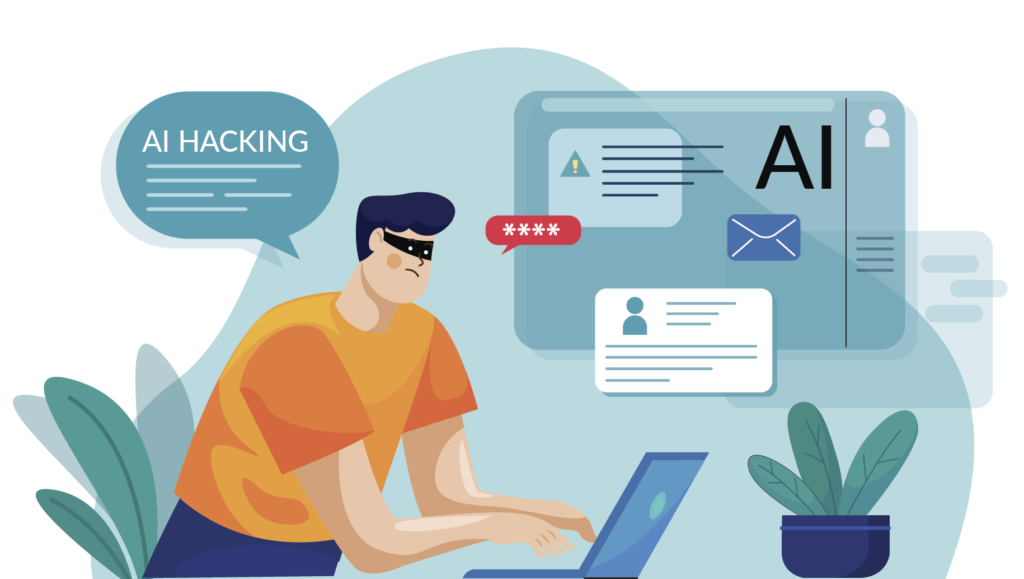Artificial intelligence (AI) has revolutionized businesses, enhancing customer engagement, expediting response times, creating tailored solutions for each client, and more. At the same time, AI’s capabilities have not gone unnoticed by hackers, who leverage it to advance their illegal activities.
According to Forbes, there were 2,365 cyberattacks in 2023, which is a 72% increase from 2021. This sharp rise in data breaches and other cyberattacks is largely attributed to the sophisticated use of AI by cybercriminals. In this blog, we’ll explore how hackers use AI to target and attack companies.
Convincing Phishing Emails
Hackers have found that generative AI tools make it easier than ever to send convincing phishing emails, tricking recipients into sharing private or sensitive information. AI-generated emails can now mimic the tone, language, and style of legitimate sources, making them difficult to distinguish from genuine communications. Even the most cautious and vigilant employees can fall prey to these well-crafted emails, putting the entire organization at risk.
AI has also broken-down language barriers. A phishing email used to be easy to spot because it had poor language and punctuation. Now, AI technology is so good at so many languages that the text is nearly flawless. No one will see the threat unless they look closely. Even scarier is that these fake emails not only have text that looks like it came from a known source, but many of them also have pictures, videos, and other media that make the email look even more real – further enhancing its credibility.
Realistic Pictures and Other Media
Many of us have had fun creating AI-generated photos and videos, like those apps that make different versions of your picture for each decade. Some can even animate a still picture and add sound to it to make it look like it’s speaking or singing. Even though it’s all hilarious within our own circles, hackers have quickly found nefarious uses for this technology.
For instance, a seemingly familiar contact might send you a video call on Messenger. When you answer, you think you see them, but it’s actually an AI-generated video clip designed to deceive you. This is unchartered territory for many of us and opens up a new layer of risk. Companies must have, and train for, heightened awareness and caution when receiving, opening and responding to communications.
Automated Attacks
AI software enables hackers to identify vulnerabilities in a company’s security with ease. Compared to the days when the bad guys would spend weeks or months manually digging to find a vulnerability to exploit and gain access to a business’s data, these tools can automatically pinpoint holes or weak spots to break into networks or security systems. It also gives hackers the ability to launch simultaneous attacks on multiple businesses, increasing their chances of success.
Understanding these techniques can help you recognize the significance of continuous monitoring and regular security audits. This will allow you to proactively patch vulnerabilities and reduce the risk of widespread breaches.
Concealing Malware
Even the most advanced and sophisticated security systems can’t stop AI-made malware from evading detection. Malware made with artificial intelligence differs from older, more traditional, malware because it has extra features that give it the power to adapt its code or behavior to avoid detection – resulting in protection from even the most careful security tools. Once this software gets through, the hackers will get into the network whenever they want.
The adaptability of AI-driven malware has forced companies to adapt their security as well. By implementing advanced threat detection systems and maintaining a multi-layered security approach, you can better protect against these evolving threats.
Orchestrating Complex Phishing Campaigns
AI simplifies every step of a phishing campaign including email or text spoofing, social engineering, and hidden links. Beyond generating convincing text, AI programs can gather and analyze data from various online sources. This information allows hackers to tailor their attacks to specific targets, increasing the likelihood of success. While this might seem like more work, hackers can do it more efficiently, and effectively, because AI does it all.
These techniques highlight the need for comprehensive employee training programs and the implementation of sophisticated email filtering to help you stay one step ahead of potential phishing attacks.
Conclusion
Hackers are constantly evolving their methods, and today, AI is their biggest ally. Using it to breach company defenses in increasingly sophisticated ways is their playground. To protect your network and data, it’s important to not only understand how hackers use AI today, but to know how to counter their techniques. If your in-house IT team could use some support, or you are a SMB trying to manage your IT on top of running the business, a managed IT service provider like Spera Partners can take the load (and the worry) off your shoulders.
We specialize in protecting businesses and schools from advanced cyber threats. Our team can help you enhance your security, stay ahead of the hackers, and get the peace of mind that comes with knowing you are secure. For a free consultation, Book a Meeting with our President, Brian Hess, or complete a form below to get started. We can’t wait to meet you.
For Businesses: https://sperapartners.com/business-solution-complimentary-consultation/
For Schools: https://sperapartners.com/Complimentary-Consultation/
Spera Partners
Managed IT.
Peace of Mind, Redefined.
For more information on our Cybersecurity Solutions: https://sperapartners.com/cybersecurity/














